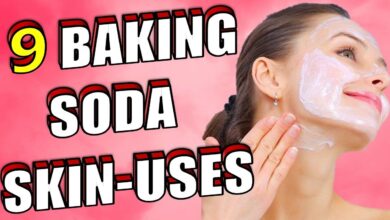Are you looking for a cost-effective and natural way to enhance the brightness of your smile?
Everyone desires a bright and radiant smile. Teeth yellowing is a common issue caused by factors such as consuming coffee, tea, and certain foods, as well as poor oral hygiene. Many commercial teeth whitening products are available on the market, but they can be expensive and may contain harsh chemicals.
However, nature has provided us with a natural and inexpensive solution, baking soda. we will explore the benefits, methods, and safety precautions of using baking soda for teeth whitening.
What is Baking Soda?
Baking soda, also known as sodium bicarbonate, is a white crystalline powder derived from a natural mineral called natron. It has been used for centuries across various cultures for its versatile properties and it is famous for its ability to both brighten and cleanse.
Baking soda is non-toxic, inexpensive, and easily available, making it a popular household item.
Benefits of Baking Soda for Teeth Whitening
Baking soda, or sodium bicarbonate, has been used for oral care for centuries. Its mild abrasive properties help remove surface stains, making it an effective teeth-whitening agent. Here are some key benefits:
Stain Removal: Baking soda’s gritty consistency helps to break down and remove built-up stains on the surface of the teeth, resulting in a brighter smile.
Neutralizes Acidity: Baking soda has a high pH level, which helps neutralize the acidity in the mouth. This prevents the growth of harmful bacteria that can lead to tooth decay and discoloration.
Antibacterial Properties: Baking soda possesses natural antibacterial properties, reducing the risk of gum disease and promoting overall oral health.
How Does Baking Soda Whiten Teeth?
Baking soda works as a teeth whitening agent by interacting with the stains on your teeth. It is mildly abrasive, which helps to remove the surface stains caused by certain foods, beverages, and smoking.
Additionally, baking soda has alkaline properties, which can create an environment that discourages the growth of bacteria.
Step-by-Step Guide: How to Use Baking Soda for Teeth Whitening
1. Gather your supplies:
2. Prepare the baking soda paste:
In a small dish, mix a teaspoon of baking soda with a few drops of water. Gradually add water until you achieve a thick paste consistency. Ensure that the paste is not too runny, as it may be difficult to apply evenly.
3. Brush with the baking soda paste:
Dip your toothbrush into the baking soda paste. Gently brush your teeth in circular motions, focusing on the visible stains.
Be cautious not to scrub too hard, as excessive abrasion could damage your tooth enamel. Instead, use gentle and controlled movements.
4. Allow the baking soda to sit:
After brushing, let the baking soda paste sit on your teeth for about 2 minutes. This will enable the alkaline properties to work on breaking down stains.
5. Rinse thoroughly:
Spit out the baking soda paste and rinse your mouth thoroughly with water. Make sure to remove all traces of baking soda from your teeth and mouth.
6. Brush with regular toothpaste:
To complete the process, brush your teeth with your regular toothpaste. This helps to neutralize the taste of baking soda and ensures that your teeth are properly cleaned and protected.
Methods of Using Baking Soda for Teeth Whitening
Although baking soda is a safe and natural teeth-whitening option, it is essential to use it correctly to avoid any potential damage. Here are four effective methods:
Baking Soda Toothpaste
- Combine two parts baking soda with one part water to form a paste.
- Dip your toothbrush into the paste and brush your teeth gently for two minutes.
- Spit out the mixture and rinse your mouth thoroughly with water.
- Use this toothpaste no more than three times per week to prevent enamel erosion.
Baking Soda and Lemon Juice
- Mix one teaspoon of baking soda with enough freshly squeezed lemon juice to form a paste.
- Apply the paste onto your toothbrush and brush your teeth gently for one minute.
- Rinse your mouth thoroughly with water and avoid leaving the mixture on the teeth for extended periods due to the acidic nature of lemon juice.
- Limit the use of this method to once a week to prevent enamel erosion.
Baking Soda and Hydrogen Peroxide
- Combine one to two teaspoons of baking soda with enough hydrogen peroxide to create a paste.
- Apply the mixture onto your toothbrush and brush your teeth gently for two minutes.
- Rinse your mouth thoroughly with water.
- Use this method once or twice a week, as excessive use may cause gum irritation.
You can also choose yo use Colgate Baking Soda and Peroxide Whitening Toothpaste. Works best you don’t want to use plain baking soda and peroxide.
Baking Soda and Coconut Oil
- Mix two teaspoons of baking soda with one teaspoon of coconut oil to form a paste.
- Apply the paste onto your toothbrush and brush your teeth gently for two minutes.
- Rinse your mouth thoroughly with water.
- Repeat this method two to three times a week to maintain white teeth and improve oral health.
Safety Precautions and Tips
- Limit usage: Use baking soda for teeth whitening no more than once or twice a week. Excessive use may lead to enamel erosion.
- Avoid contact with gums: Be careful while brushing near the gumline, as baking soda can irritate sensitive gums. If irritation occurs, discontinue use.
- Test sensitivity: Before incorporating baking soda into your oral care routine, apply a small amount on the inside of your arm. If no adverse reactions occur, it is generally safe to use.
- Keep it separate: Avoid using the same toothbrush for baking soda and regular toothpaste. The residue of baking soda may interfere with the fluoride benefits of toothpaste.
- Regular dental care: Remember that baking soda should never replace good oral hygiene practices like regular brushing, flossing, and professional dental cleanings.




